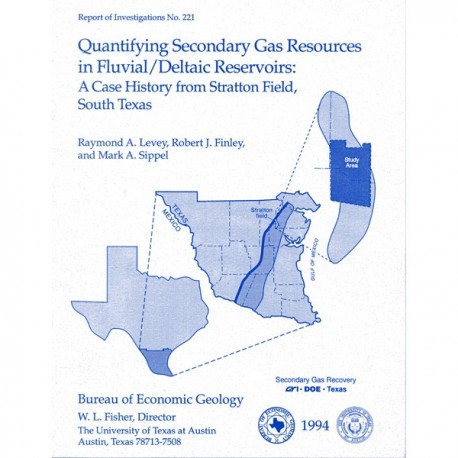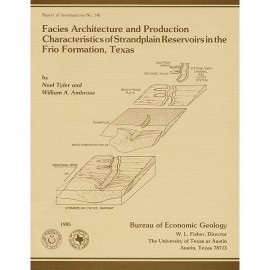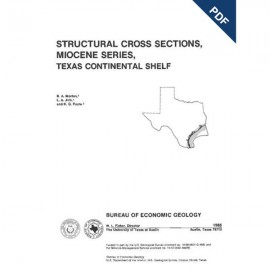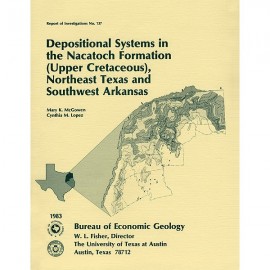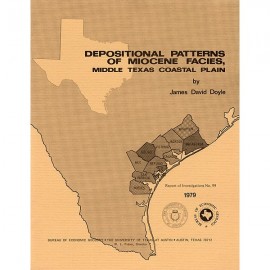Reports of Investigations
-
Books & Reports
- Reports of Investigations
- Guidebooks
- Udden Series
- Geological Circulars
- Down To Earth
- Atlases of Major Oil and Gas Reservoirs
- Texas Memorial Museum Publications
- Environmental Geologic Atlas of the Texas Coastal Zone
- Mineral Resource Circulars
- Other Reports
- Seminars and Workshops
- Handbooks
- Submerged Lands of Texas
- Symposia
- Annual Reports
- Open File Reports
-
Maps & Cross Sections
- Thematic Maps
- Miscellaneous Maps, Charts & Sections
- Geologic Atlas of Texas
- STATEMAP Project Maps
- Geologic Quadrangle Maps
- Cross Sections
- Highway Geology Map
- Energy and Mineral Resource Maps
- Shoreline Change and Other Posters
- Wilcox Group, East Texas, Geological / Hydrological Folios
- Bouguer Gravity Atlas of Texas
- River Basin Regional Studies
- Featured Maps
- Posters
- Teachers & the Public
-
Geological Society Publications
- Gulf Coast Association of Geological Societies
- Alabama Geological Society
- Austin Geological Society
- Corpus Christi Geological Society
- Houston Geological Society
- Lafayette Geological Society
- Mississippi Geological Society
- New Orleans Geological Society
- South Texas Geological Society
- GCS SEPM Publications
- Historic BEG & UT Series
Quantifying Secondary Gas Resources in...Reservoirs:...Stratton Field, South Texas
RI0221
For a downloadable, digital version: RI0221D.
RI0221. Quantifying Secondary Gas Resources in Fluvial/Deltaic Reservoirs: A Case History from Stratton Field, South Texas, by R. A. Levey, R. J. Finley, and M. A. Sippel. 38 p., 41 figs., 3 tables, 2 appendices, 1994. Print.
To purchase this publication as a downloadable PDF, please order RI0221D.
ABSTRACT
Geologic and engineering studies were conducted within fluvial/deltaic strata of a mature South Texas field to determine the impact of reservoir compartmentalization on secondary gas recovery. Stratton is one of several mature South Texas fields containing fluvial and deltaic gas reservoirs. This study documents the effect of depositionally controlled reservoir heterogeneity in a field with fluvially dominated reservoir architecture. Stratigraphic and production analysis of natural gas reservoirs within the fluvial facies tract of the Oligocene-age middle Frio Formation demonstrates the importance of evaluating gas-well completion spacing in areas containing multiple stacked reservoirs. Historical analyses of a densely drilled, contiguous 10-mi2 area in this field demonstrate that production decline and reserves depletion were slowed by an aggressive infield reexploration program. A quantitative case history developed during this study evaluates infield drilling and recompletions and documents the greater than 90-percent reserve replacement that was achieved after 42 years of development between 1937 and 1979.
Depositionally heterogeneous fluvial reservoirs are prime candidates for the development of incremental hydrocarbon resources. An integrated geologic and engineering analysis of successful reserve growth at less than 320-acre completion spacing within heterogeneous gas reservoirs provided an infield reservoir compartment nomenclature that can be used to evaluate gas reservoirs in other fields. Three reservoir case studies outlined in this report show that reserve additions come from new infield reservoirs, untapped reservoir compartnzents, and incompletely drained reservoir compartments. Secondary (or incremental) gas reserves in the study area are greater than 65 Bcf. Economic analysis of a major infield development program indicates a finding cost of less than $0.70 per Mcf (in 1990 dollars). Documenting the occurrence of natural gas reserve growth and the steps leading to the geologic and engineering identification of secondary gas resources will help operators improve recovery from these fluvial heterogeneous reservoirs.
Keywords: deltaic reservoirs, fluvial architecture, infield drilling, reserve growth, reservoir-compartmentalization, reservoir heterogeneity, secondary natural gas, Stratton field, Texas
CONTENTS
Abstract
Introduction
Objective of Secondary Gas Recovery Research
Reservoir Compartment Terminology
A Case History: Stratton Field
Regional Setting of Stratton Field
Stratton Field Development History
Structure and Stratigraphy-Wardner Lease Study Area
Reserve Growth Analysis
Method for Gas Reserve Growth Assessment
Hindcast Analysis of Reserve Growth (1979 to 1990)
Impact of Infield Drilling (1986 to 1990)
Changes in Well Spacing and Reservoir Completion Density (1979 to 1990)
Forecast for Gas Reserve Growth (1990 to 2009)
Examples of Infield Reserve Growth Reservoirs
Example 1: New Infield Reservoir (F-21)
Pressure Tests
Magnitude of SGR Resource
Example 2: Untapped Reservoir Compartments (F-37)
Magnitude of SGR Resource
Example 3: Incompletely Drained Reservoir Compartment (F-20)
Application of Results
Recovery Factor
Economics of Secondary Gas Recovery
Texas Gas Plays with Similar Attributes
Conclusions
Acknowledgments
References
Appendix 1: Nomenclature
Appendix 2: SI Metric Conversion Factors
Figures
1. Diagram of reservoir compartment terminology illustrating variation in reservoir compartment position and relation to perforations in well bores within a field
2. Relative ranking of gas volume produced from 10 depositional episodes of the onshore Gulf Coast Basin
3. Schematic depositional dip-oriented cross section through the central Texas Gulf Coast Basin illustrating relative position of major sand depocenters
4. Location map showing Stratton field within the Frio Fluvial/Deltaic Sandstone (FR-4) play
5. Annual gas production of Stratton field, 1950 to 1991
6. Generalized stratigraphic column of Eocene and younger strata in onshore South Texas
7. Stratton-Agua Dulce field complex showing lateral extent of the two major productive reservoirs. Bertram and Wardner
8. Middle Frio and lower Frio and Vicksburg reservoirs in Stratton field, 1940 to 1990
9. Ratio of active middle Frio reservoirs to total active reservoirs (Frio and Vicksburg) in Stratton field, 1944 to 1989
10. Reservoir discovery year versus reservoir depth, Stratton field
11. Location of Wardner lease study area, Stratton field
12. Structure-contour map on a shale marker in D series reservoir of middle Frio showing gentle structural domal closure typical of reservoir intervals in the middle Frio Formation
13. Subregonal dip-oriented cross section A-A', interpreted from seismic data, through Wardner lease study area showing rotation of fault blocks in lower Frio and Vicksburg Formations in comparison to lack of faulting in upper and middle Frio Formations
14. Well log from center of the Wardner lease study area, showing Frio and Vicksburg Formation reservoir nomenclature
15. Semilog plots of production rate with time for wells, Wardner lease study area
16. Cumulative frequency plot of reservoir pressure for all completions at depths above 7,000 ft, 1979 to 1990, Wardner lease study area
17. Gas-producing rate with time, 1970 through 1989. Stratton field
18. Reserve additions before 1979 and after 1978 in reservoirs above and below 7,000 ft
19. Reservoir nomenclature developed by gas operators in Nueces and Kleberg Counties
20. Reserve additions of reservoirs grouped by series and stratigraphic interval, Wardner lease study area
21. Number of completions by depth category, Wardner lease study area
22. Total gas volume of all completions, Wardner lease study area
23. Gas volume of completions at depths above 7,000 ft, Wardner lease study area
24. Gas volume of completions at depths below 7,000 ft, Wardner lease study area
25. Cumulative completions grouped by reservoir series, Wardner lease study area
26. Active completions through time, Wardner lease study area
27. Historical production and projections of production rate versus time, Wardner lease study area
28. Location of the three infield reserve growth examples documented in this study
29. Three reservoir compartment types in Stratton field and estimated ultimate gas volumes of incremental resource calculated for the three examples
30. Stratton field study area example 1 before 1988 and in 1991
31. Stratigraphic cross section B-B' illustrating a new infield reservoir
32. Pressure versus cumulative gas plot of three completions in a new infield reservoir
33. Map view of well-bore penetrations, completions, and structural horizon in multiple reservoir compartments
34. Stratigraphic cross section C-C' showing multiple reservoir compartments
35. Composite pressure versus time plot of multiple reservoir compartments
36. Pressure versus composite cumulative gas plot of multiple reservoir compartments
37. Map view of well-bore penetrations, completions, and structure horizon in an incompletely drained reservoir compartment
38. Stratigraphic cross section of an incompletely drained reservoir compartment
39. Composite pressure versus time plot of an incompletely drained reservoir compartment
40. Pressure versus composite cumulative gas plot of an incompletely drained reservoir compartment
41. Location of major Texas gas plays containing fluvial/deltaic reservoirs
Tables
1. Major stratigraphic gas-bearing intervals in Stratton field
2. Average well and reservoir completion spacing at different times, Wardner lease study area
3. Development history of Stratton field
Citation
Levey, R. A., Finley, R. J., and Sippel, M. A., 1994, Quantifying Secondary Gas Resources in Fluvial/Deltaic Reservoirs: A Case History from Stratton Field, South Texas: The University of Texas at Austin, Bureau of Economic Geology, Report of Investigations No. 221, 38 p.
